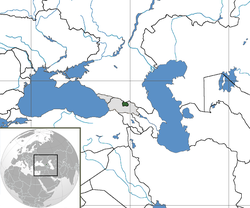
Back Аахыҵ Уаԥстәыла Abkhazian Suid-Ossetië Afrikaans ደቡብ ኦሤትያ-አላኒያ Amharic Osetia d'o Sud AN दक्षिण ओस्सेटिया ANP أوسيتيا الجنوبية Arabic اوسيتيا الجنوبيه ARZ Osetia del Sur AST Бакъда Гьиристан AV Cənubi Osetiya Azerbaijani
Republic of South Ossetia – The State of Alania | |
|---|---|
| Anthem: National Anthem of South Ossetia National Anthem of South Ossetia – Республикӕ Хуссар Ирыстоны Паддзахадон Гимн | |
 South Ossetia (green), Georgia, and Abkhazia (light grey). | |
 Map of South Ossetia. | |
| Status | Partially recognised state Recognised by the United Nations as de jure part of Georgia |
| Capital and largest city | Tskhinvali 42°14′N 43°58′E / 42.233°N 43.967°E |
| Official languages | |
| Recognised regional languages | Georgian |
| Government | Semi-presidential republic |
| Alan Gagloyev | |
| Gennady Bekoyev | |
| Legislature | Parliament |
| Independence from Georgia | |
• Formed as part of USSR | 20 September 1990[1] |
• Act of state independence | 21 December 1991 |
• Recognized | 26 August 2008 (limited) |
| Area | |
• Total | 3,900 km2 (1,500 sq mi) |
• Water (%) | negligible |
| Population | |
• 2015 census | 53,532 (212th) |
• Density | 13.7/km2 (35.5/sq mi) |
| GDP (nominal) | 2017[2] estimate |
• Total | US$0.1 billion |
• Per capita | US$2,000 |
| Currency | Russian ruble (RUB) |
| Time zone | UTC+03:00 (MSK) |
| Driving side | right |
| Calling code | +995 34 |
South Ossetia (/ɒˈsɛtjə/, less commonly /ɒˈsiːʃə/),[4] officially the Republic of South Ossetia – the State of Alania,[5][6] or the Tskhinvali Region, is a de facto,[7] disputed territory recognised as part of Georgia in the Caucasus region.
South Ossetia was a Soviet oblast (region) with some self-rule and controlled big parts of the region. When it declared its independence in 1990, Georgia tried to take back the region by force and it led to the 1991-1992 South Ossetia War.[8] Georgia tried to retake South Ossetia again in 2004 and in 2008.[9] In 2008, Ossetia's fighters were backed by Russian troops and they gained full control of the region, but its separation from Georgia has only been recognized by three other countries (Russia, Nicaragua and Venezuela) and Abkhazia[10][11] (a similar place), and it is de jure (officially) a part of the Georgian region (mkhare) of Shida Kartli.
Internationally regarded as a Russian occupied territory of Georgia, Georgia itself refuses to recognize rebel South Ossetia as an independent state; the government calls it by the medieval name of Samachablo or, more recently, Tskhinvali region (after the republic's capital).
South Ossetia is a geographical state that borders North Ossetia-Alania to the north which is not an independent entity due to it being part of Russia.
South Ossetia relies heavily on Russian aid.[12][13][14]
Sometimes, South Ossetia, Transnistria, Nagorno-Karabakh, and Abkhazia are named collectively as post-Soviet "frozen conflict" zones.[15][16]
- ↑ "Unrecognized states: South Ossetia" (in Russian). 28 January 2014. Archived from the original on 5 May 2014. Retrieved 5 May 2014.
- ↑ "Валовой внутренний продукт". Archived from the original on 13 April 2018. Retrieved 12 April 2018.
- ↑ Presidential Elections in South Ossetia – Plan B
The first round of voting was accompanied by a referendum in which the Ossetians were to decide whether Russian should become the second official language of South Ossetia. Nearly 85 per cent of the voters supported the referendum.
- ↑ "Ossetia" Archived 23 October 2018 at the Wayback Machine. Collins English Dictionary.
- ↑ "South Ossetia Referendum on Name Change Steers Clear of Thornier Unification Issue". RadioFreeEurope/RadioLiberty. Archived from the original on 14 September 2017. Retrieved 23 July 2018.
- ↑ "Referendum to rename South Ossetia 'Alania' set for April". OC Media. 7 February 2017. Archived from the original on 24 July 2018. Retrieved 23 July 2018.
- ↑ De facto - in practice, not necessarily in law
- ↑ The Foreign Policy of Russia: Changing Systems, Enduring Interests. Robert H. Donaldson, Joseph L. Nogee. M.E. Sharpe. 2005. p. 199. ISBN 9780765615688.
{{cite book}}: CS1 maint: others (link) - ↑ Charles King (2008). "The Five-Day War: Managing Moscow After the Georgia Crisis" (PDF). Foreign Affairs (November/December). Georgetown University. Archived (PDF) from the original on 23 September 2014. Retrieved 22 June 2010.
- ↑ Hille, Charlotte (2010), Companjen, Françoise; Versteegh, Lia; Marácz, László (eds.), "The Recognition of Abkhazia and South Ossetia: A New Era in International Law", Exploring the Caucasus in the 21st Century: Essays on Culture, History and Politics in a Dynamic Context, Amsterdam University Press, pp. 195–210, ISBN 978-90-485-1162-4, retrieved 2023-10-16
- ↑ "Chavez Recognizes South Ossetia, Abkhazia". RadioFreeEurope/RadioLiberty. Retrieved 2023-10-16.
- ↑ "South Ossetia Looking Much Like a Failed State". Associated Press. Archived from the original on 8 July 2010. Retrieved 12 July 2010.
- ↑ "NATO Membership Would Strain Georgia's Ties with Russia – Medvedev". RIA Novosti. 7 August 2013. Archived from the original on 18 October 2015. Retrieved 23 October 2015.
- ↑ Smolar, Piotr (8 October 2013). "Georgia wary of Russian encroachment". The Guardian. Archived from the original on 6 March 2017. Retrieved 16 December 2016.
- ↑ OSCE: De Gucht Discusses Montenegro Referendum, Frozen Conflicts Archived 27 March 2014 at the Wayback Machine, GlobalSecurity.org Archived 28 February 2011 at the Wayback Machine, Radio Free Europe/Radio Liberty Archived 24 February 2011 at the Wayback Machine, May 2006
- ↑ Vladimir Socor, "Frozen Conflicts in the Black Sea-South Caucasus Region". Archived from the original on June 5, 2013. Retrieved 2014-03-26.
{{cite web}}: CS1 maint: bot: original URL status unknown (link), IASPS Policy Briefings, 1 March 2004

